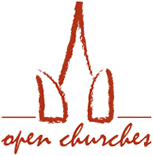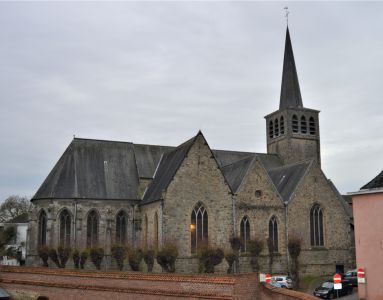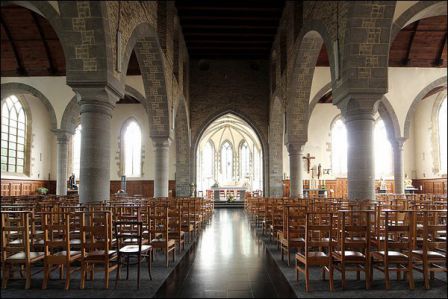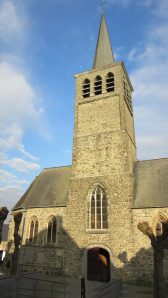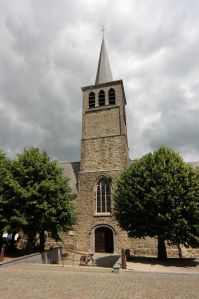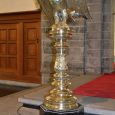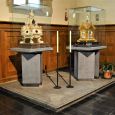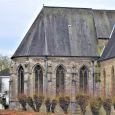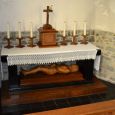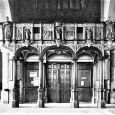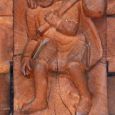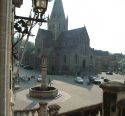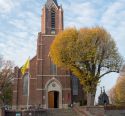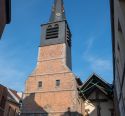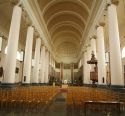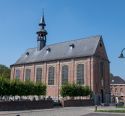Church | 1075 - 1952 | Romanesque, Gothic | Catholic Church



Map
Opening hours
01 April - 31 October
Mon 9.30 - 17.30
Tue 9.30 - 17.30
Wed 9.30 - 17.30
Thu 9.30 - 17.30
Fri 9.30 - 17.30
Sat 9.30 - 17.30
Sun 9.30 - 17.30
01 November - 31 March
Mon 9.30 - 16.00
Tue 9.30 - 16.00
Wed 9.30 - 16.00
Thu 9.30 - 16.00
Fri 9.30 - 16.00
Sat 9.30 - 16.00
Sun 9.30 - 16.00
Description
The edifice occupies the site of a primitive chapel replaced by a first Romanesque church before 1075, itself replaced by a second one at the end of the 12th century. Since then, the building has undergone more than a dozen campaigns of extensions, transformations and restorations.
Annihilated on May 11, 1940 by a few German incendiary shells, the church lived a real ordeal, with restoration work only beginning in early 1950 and leading to the consecration on May 22, 1952. Through his work, the architect Simon Brigode was keen to restore the original purity and luminosity of the monument, which had been listed since 1941.
If the tower and the light-floor of the great nave date back to the second Romanesque church of the 12th century, the major part of the building is Gothic, a style perpetuated throughout the various campaigns of work that took place between 1356 and 1817.
Some works of art and furniture saved from the 1940 disaster have found a place in the church while the last war damages were attributed late: large organ in 1989, baptismal font, side altars and 3 bells only in 2013.
Welcoming, luminous, historical and educational, the church of Saint-Pierre is only waiting for one thing: your visit!
KIKIRPA : Photo-library online
Photos
Remarkable elements
Eagle-lutrin
As indicated by the initials P.D.L.P.M.F. (Pierre De LesPesse Me Fecit) at the top of the curved foot and the year 1647 on the globe, this remarkable work in brass was made by the foundryman Pierre de Lespesse in the middle of the 17th century. The eagle symbolizes the evangelist John, "the Eagle of Patmos", but it is also an image of Good overcoming Evil, the bird holding an overturned dragon in its claws.
Installed under the triumphal arch of the choir in 1940, the work withstood the force of the fire and regained its function in the restored church.
Shrines of Saint-Mansuète
It was in 1685 that the relics of the second patron saint of the parish, a young Roman martyr of the 3rd century, Saint Mansuet, arrived. The major part of his body was housed in a baroque reliquary, made of stuccoed and gilded linden wood and surmounted by the bust of the young boy until 1901, an important family from Lessin chose a new shrine from the catalogue of the goldsmiths Wilmotte and son in Liège, a neo-Gothic work in gilded and silvered copper.
Since 1952, the two shrines have been exhibited together, the 1901 shrine containing the relics.
Choir
Made of Tournai stone, it was built in 1356 and is one of the few important 14th century religious buildings in the region. On the outside, even if altered, one can still notice the delicate carved decoration of the windows: flowers, fleurons, and monsters. Inside, the graceful small columns, placed on a bench, only received their vaults during the 16th century, their ribs having ornamented keys: vexillaire lamb at the side and five-petalled roses in the bays. The original lamb keystone is displayed in the Memorial Space of the church (Chapel of the Holy Trinity).
Christ's Lying Face
Since the Middle Ages, St. Peter's Church has been at the center of a unique event in Northern Europe, the Good Friday Trilogy: service, procession and entombment. As the material was destroyed in 1940, a new Christ's bed was commissioned from the artist Harry Elstrøm.
At the end of the service, the Christ is escorted by penitents, illuminated by torches and lanterns, with the sound of rattles and drums in the dark city streets, before being laid to rest in the Chapel of St Barbara, also known as the Chapel of Our Lady of the Seven Sorrows.
The rood screen
Installed in the triumphal arch of the choir in 1616, the rood screen was a limited copy of the one in Tournai Cathedral. Moved to the back of the central nave in 1758, it was there that the work was damaged in 1940. Its railing was fortunately removed in 1941 before its vaults collapsed. Like many pieces of furniture of the genre, the rood screen of Lessines represents various episodes of the Passion but is also populated with statues and coats of arms. Its main elements - large scenes, niches, statues and spandrels of the arcades - are displayed in the Space of Memory.
Modillions
These 86 modillions, intended to support the edges of the oak shingle vaults of the various chapels, were commissioned from the Belgian artist Basile Lamon, winner of the Prix de Rome in 1947. The sculptor was inspired by subjects from the Old and New Testaments, Eucharistic symbols, but also by the various trades involved in the restoration. To discover these sculptures, don't forget to bring binoculars, or go to the Sainte-Barbe chapel where their photos are on display!
